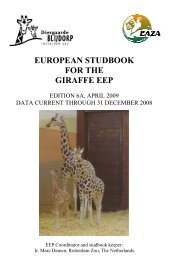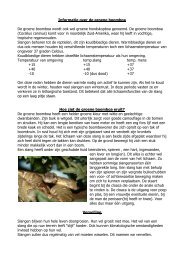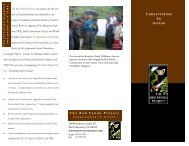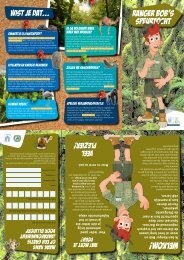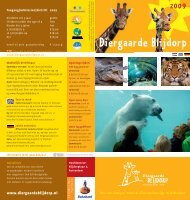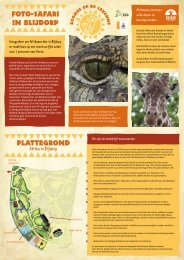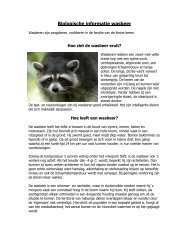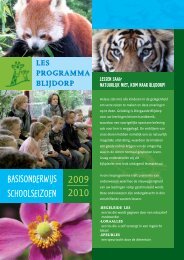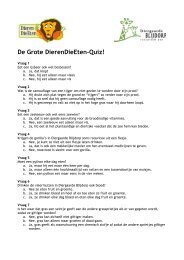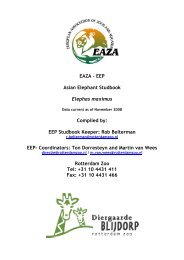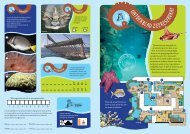Create successful ePaper yourself
Turn your PDF publications into a flip-book with our unique Google optimized e-Paper software.
<strong>EEP</strong> STUDBOOK CROWNED PIGEONS SUMMARIES<br />
1.5 Recommendations for ex situ management<br />
A crowned <strong>pigeon</strong> <strong>EEP</strong> Species Committee meeting chaired by species coordinator Ing. Joeke<br />
Nijboer (Rotterdam) was held in 1997. It was agreed that the <strong>EEP</strong> would offer to take the<br />
seven remaining Goura scheepmakeri in North America as suggested by the crowned <strong>pigeon</strong><br />
SSP. It was also agreed that a location to experiment with pair formation within a group of<br />
crowned <strong>pigeon</strong>s would be searched for, as reproductive results might improve if the birds<br />
were given the opportunity to choose their own mates. It was suggested that the incoming<br />
group of Goura scheepmakeri would provide a good opportunity to make an attempt. It was<br />
proposed that the U.K. would focus on Goura victoria (Bolton, 1997).<br />
Nest heights: a pair of Goura victoria nested 3 - 4 m from the ground level when the choice is<br />
given, while a pair of Goura scheepmakeri at Copenhagen Zoo nested 2 - 2.5 m from the<br />
ground when given a free choice (Bolton, 1997).<br />
The goal for a breeding program for crowned <strong>pigeon</strong>s determines whether seperate breeding<br />
programs for sub-species are required. If re-introduction of captive-born individuals into the<br />
original populations belongs to one of the topics in the future, even each island-form of the<br />
common crowned <strong>pigeon</strong> should be bred in separate enclosures. Hybridization of sub-species/<br />
populations might be allowed when preservation of the captive population or introduction<br />
under semi-wild conditions are the only options.<br />
In the latter case, it is merely a matter of opinion where zoos show "pure" forms or a lookalike<br />
of a species. Hybridization will probably not result in outbreeding depression, which can<br />
occur when sub-species or populations are so genetically different that hybridization will<br />
result in offspring with reduced fitness (Templeton, et al., 1986).<br />
Outbreeding depression is expected to occur when isolated populations are genetically<br />
adapted to specific conditions in their environment. Since the (sub-)species of crowned<br />
<strong>pigeon</strong>s seem to inhabit the same type of environment, special genetic adaptations are not<br />
expected. The three species of Goura seem not to differ in chromosomal features (De Boer<br />
and Belterman; Belterman and De Boer in Assink, 1988). Recent DNA-research (Bohmke and<br />
Patton in Wetzel, 1991) proved that the DNA pattern of the three species are so much<br />
different from each other, that the DNA pattern does not point to different sub-species, but<br />
must be considered as three species.<br />
The close affinity of the "pure" species, indicates that the period of isolation of their islandforms<br />
might be too short to develop large genetic differences (Assink, 1988). Assink<br />
suggested maintaining a breeding program for Goura victoria and also one for Goura cristata<br />
and don’t differ between the sub-species. The differences between the two subspecies of<br />
Goura scheepmakeri are larger, so he would like to start separate breeding programs for each<br />
subspecies of Goura scheepmakeri, but the low <strong>number</strong> of both populations does not allow a<br />
division into two breeding populations (Assink, 1988).<br />
The breeding success of crowned <strong>pigeon</strong>s in captivity is low in comparison to the <strong>number</strong> of<br />
offsprings they can produce theoretically. It is important to know how many birds are<br />
required to maintain viable populations.<br />
12



